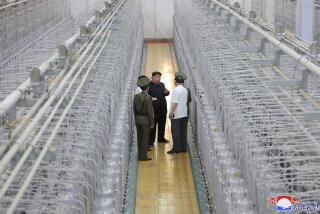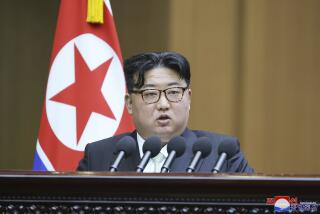N. Korea says it shut down reactor; inspectors arrive
- Share via
WASHINGTON — North Korea told U.S. officials Saturday that it had shut down its nuclear reactor, a major move by the nation’s reclusive and unpredictable leaders toward scaling back their controversial nuclear program.
U.S. State Department officials made the announcement as a team of U.N. inspectors arrived in North Korea to begin monitoring the Yongbyon nuclear complex.
The statement came just hours after North Korea received an initial shipment of fuel oil from South Korea that had been promised, along with other economic aid and better diplomatic ties, in exchange for disabling its nuclear facilities.
“We welcome this development and look forward to the verification and monitoring of this shutdown by the International Atomic Energy Agency team,” State Department spokesman Sean McCormack said.
The Vienna-based IAEA serves as the nuclear watchdog for the United Nations.
The United States, South Korea, China, Russia and Japan have engaged North Korea in negotiations since 2003 in an effort to halt its nuclear program.
McCormack said Saturday that the U.S. was looking forward to meetings set for this week to discuss implementing North Korea’s pledge to disable “all its existing nuclear facilities.”
North Korea, which began seeking to develop nuclear weapons two decades ago, evicted U.N. arms inspectors in December 2002 and shortly thereafter pulled out of the Nuclear Nonproliferation Treaty. It then restarted the Yongbyon reactor, which had been mothballed under a treaty signed in 1994 during the Clinton administration.
Given the high value the North Korean government has placed on its nuclear program, analysts who watch its activities warned that though Saturday’s developments were a positive sign, coming negotiations probably would be difficult and complex.
“Many people share the concern of whether North Korea will go to the next step” and continue dismantling its nuclear facilities, said John Park, coordinator of the Korea Working Group at the nonpartisan U.S. Institute of Peace. “For now, the shutting down of the reactor has been happening relatively smoothly, with the arrival of the oil and of the IAEA team, but this is just one of many steps.”
The next phase of negotiations is to take place Wednesday in Beijing, where representatives of the six nations will meet to discuss how and when North Korea’s nuclear facilities would be disabled in a way to render them unusable.
The U.S. and the other countries exerting pressure on the government in Pyongyang, “are trying to avoid a situation where North Korea can shut down a reactor and very easily turn it on again,” Park said. “The heavy lifting is working out a process that all sides agree to.”
A team of 10 experts from the IAEA arrived Saturday in Pyongyang, planning to remain for as long as it takes to complete their inspections at the reactor, about 60 miles northeast of the North Korean capital.
The team is returning after an absence of more than four years. North Korea expelled the agency’s last team of inspectors after the U.S. accused the country of violating the 1994 nuclear-freeze deal by secretly operating a uranium enrichment plant.
North Korea restarted its reactor then, but has shut it down occasionally to remove weapons-grade plutonium. It is now believed to have 46 to 64 kilograms of plutonium, enough for five to 12 nuclear weapons, according to a February assessment by the Institute for Science and International Security.
In October, North Korea conducted an underground nuclear test, which led to accelerated efforts by the nations involved in the six-party talks to shut down its nuclear program.
Under a two-phase agreement reached in February, North Korea promised to shut down the Yongbyon nuclear complex within 60 days, allow inspectors at the site, participate in talks on other issues and assemble a comprehensive list of its nuclear weapons and energy programs.
In exchange, the U.S. pledged to lift financial sanctions against a bank that has held North Korean assets, take steps to remove the country from the State Department’s list of state sponsors of terrorism, and move toward full diplomatic relations with the government, headed by Kim Jong Il.
The deal also called for North Korea to initially receive 50,000 tons of fuel oil to provide it an alternative supply of energy.
Some analysts in China and South Korea have said Washington bears some responsibility for the delay since the Feb. 13 agreement. They point to the handling of more than $20 million in North Korean funds held up in a Macao bank.
Even as the Treasury Department agreed to drop restrictions that prevented the funds from being released, the administration let it be known that any party or bank -- including China -- handling the funds might be considered an abettor in money laundering and other transgressions Pyongyang is accused of.
The warning sent a chill through banking circles and led to months of diplomatic wrangling.
In Saturday’s shipment, a first installment on the terms of the deal, a South Korean tanker loaded with 6,200 tons of fuel oil arrived at the port of Sonbong.
In the second phase of the agreement, the fuel supplied to North Korea would total 950,000 tons.
In return, Pyongyang would provide detailed information about all its nuclear activities and disable them.
The goal is North Korea’s “de-nuclearization,” said Scott Snyder, a North Korea specialist with the Asia Foundation in Washington.
The reactor shutdown “doesn’t get us back to where we were before this crisis started in 2002 because, obviously, the North Koreans made progress in gaining more material during the time they were operating” the facility, he said. “At least it sort of stabilizes the crisis.”
jim.puzzanghera@latimes.com
--
Times staff writer Mark Magnier in Beijing contributed to this report.
More to Read
Sign up for Essential California
The most important California stories and recommendations in your inbox every morning.
You may occasionally receive promotional content from the Los Angeles Times.














